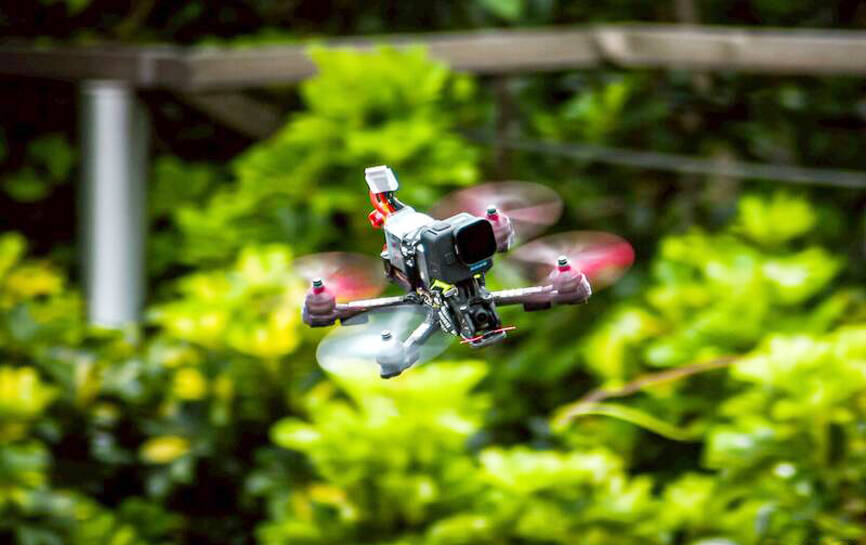The military is planning to recategorize military drones as “consumables/munitions,” rather than as aircraft, to speed up the procurement process, the army said yesterday.
The Army Command Headquarters said the decision was made because drones, like munitions, need to be rapidly replaced, and thus should be categorized as consumables/munitions “to meet the army’s practical needs.”
The headquarters’ confirmation came after the Chinese-language Liberty Times (the Taipei Times’ sister paper) early yesterday reported that the army was about to make the classification change based on the example of the US, which is Taiwan’s biggest arms provider.

Photo: Liu Yu-chieh, Taipei Times
US Secretary of Defense Pete Hegseth announced a new drone policy last month that would treat some types of smaller uncrewed aerial systems (UAS) as “consumables,” not durable property, as they are more akin to hand grenades and other kinds of ammunition than aircraft.
Lower-level commanders would also be able to procure smaller drones directly, as well as authorize subordinates to operate them, according to the US plan.
The Liberty Times quoted an unnamed source as saying that, by listing UAS as munitions, Taiwan’s military would significantly streamline the procurement process, and making it faster for them to receive and use drones.
Group 1 and Group 2 UASs would be “accounted for as consumable commodities, not durable property,” according to a memo on the US policy change released by Hegseth.
The Pentagon classifies Group 1 drones as weighing up to 9kg, that can fly up to an altitude of 365.8m and can reach speeds of up to 100 knots (185.2kph).
Group 2 drones weigh between 9.5kg and 25kg, can reach an altitude of 1,067m, and hit top speeds of up to 250 knots (463kph), according to US media reports.
Asked about the army’s latest policy change, Su Tzu-yun (蘇紫雲), a division director at the military-funded Institute for National Defense and Security Research, yesterday said the policy change would speed up and make drone procurement more flexible for the armed forces.
It would also allow the military to work closely with private drone makers and have a large number of drones produced faster to meet the need for drones in modern warfare.
The plan also shows that the armed forces are changing their mindset and are becoming more open to cooperation with the private sector, Su said.
Taiwan needs as many drones as possible, he said, citing the example of the Ukraine-Russia war.
Ukraine is producing about 3 million drones per year to defend itself against Russia, as smaller drones only have a penetration rate of 10 percent, meaning that only 10 percent of them reach their designated targets, Su said.
That is why Taiwan needs to boost its drone production capabilities as soon as possible to defend against a potential Chinese invasion, he said.

AGING: As of last month, people aged 65 or older accounted for 20.06 percent of the total population and the number of couples who got married fell by 18,685 from 2024 Taiwan has surpassed South Korea as the country least willing to have children, with an annual crude birthrate of 4.62 per 1,000 people, Ministry of the Interior data showed yesterday. The nation was previously ranked the second-lowest country in terms of total fertility rate, or the average number of children a woman has in her lifetime. However, South Korea’s fertility rate began to recover from 2023, with total fertility rate rising from 0.72 and estimated to reach 0.82 to 0.85 by last year, and the crude birthrate projected at 6.7 per 1,000 people. Japan’s crude birthrate was projected to fall below six,

Conflict with Taiwan could leave China with “massive economic disruption, catastrophic military losses, significant social unrest, and devastating sanctions,” a US think tank said in a report released on Monday. The German Marshall Fund released a report titled If China Attacks Taiwan: The Consequences for China of “Minor Conflict” and “Major War” Scenarios. The report details the “massive” economic, military, social and international costs to China in the event of a minor conflict or major war with Taiwan, estimating that the Chinese People’s Liberation Army (PLA) could sustain losses of more than half of its active-duty ground forces, including 100,000 troops. Understanding Chinese

SELF-DEFENSE: Tokyo has accelerated its spending goal and its defense minister said the nation needs to discuss whether it should develop nuclear-powered submarines China is ramping up objections to what it sees as Japan’s desire to acquire nuclear weapons, despite Tokyo’s longstanding renunciation of such arms, deepening another fissure in the two neighbors’ increasingly tense ties. In what appears to be a concerted effort, China’s foreign and defense ministries issued statements on Thursday condemning alleged remilitarism efforts by Tokyo. The remarks came as two of the country’s top think tanks jointly issued a 29-page report framing actions by “right-wing forces” in Japan as posing a “serious threat” to world peace. While that report did not define “right-wing forces,” the Chinese Ministry of Foreign Affairs was

US President Donald Trump in an interview with the New York Times published on Thursday said that “it’s up to” Chinese President Xi Jinping (習近平) what China does on Taiwan, but that he would be “very unhappy” with a change in the “status quo.” “He [Xi] considers it to be a part of China, and that’s up to him what he’s going to be doing, but I’ve expressed to him that I would be very unhappy if he did that, and I don’t think he’ll do that. I hope he doesn’t do that,” Trump said. Trump made the comments in the context